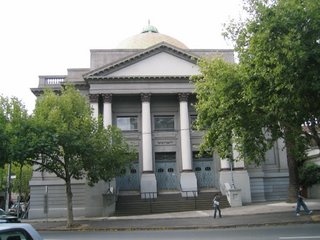 Ideas?
Ideas?Where did F W Boreham get his ideas for the subjects of his articles? The following answer relates to his editorials but as his newspaper contributions and sermon proclamations had connections this answer has implications for all his work.
Was Boreham told by the newspaper managers what subjects he should and should not address? How much was his editorial subject shaped by events and issues in the news?
Editorial freedom
An investigation of Boreham’s private papers has failed to discover whether there were specific directions and guidelines given to him by the owners and editor of the Mercury and the Age about his editorial writing. The editorial constraints on writing a Saturday leader appeared minimal, for Boreham exclaimed that he had “ample scope” for developing articles on “all kinds of historical, scientific and literary themes” and he researched topics for editorials that could also be worked into his sermons and books of essays.[1] Keeping a long list of themes upon which some day he thought he might write,[2] and revelling in his authorial freedom, Boreham stated: “An essayist is a privileged scribe: he is under no obligation to explain his choice of a theme .... his work is apropos de rien: it has no connexions or relationships. He may open his lips whenever he likes on any subject that takes his fancy. Nobody, therefore, has any right to ask my reason for selecting my present subject. And certainly nobody will guess it”.[3]
While it is unclear whether the above statement referred to his Saturday editorials as well as to his published essays, Boreham was largely unrestricted as an editorialist and he prided himself on never having an editorial rejected or altered by an editor.[4]
Observer of days
Throughout his writing career Frank Boreham regularly returned to address the familiar subjects from his developing editorial ‘lectionary’. Most years he wrote articles for the following days, events and seasons (as recognised in the southern hemisphere):
New Year
The holiday season (summer holidays in December-January)
Australia Day (Waitangi Day, when writing in New Zealand)
Return to work (January-February)
Easter
Anzac Day (from 1916 onwards)
Autumn
Mothers’ Day (May)
Empire Day (celebrated on 24 May since 1905 until 1953 when it was replaced by Queen Elizabeth’s birthday and observed on 11 June)
Empire Youth Day (May)
Mid-winter’s Day
Wattle Day (observed on 1 September from 1910 and on 1 August from 1916 although observance has weakened since WWII)
August
Spring (September)
Show Day (In Tasmania the Agricultural show day is celebrated in October.)
Armistice or Remembrance Day (November)
Bible Sunday (first Sunday in Advent)
End of school year (December)
Christmas
End of Year
The regularity of these articles gave structure, predictability and a rhythm to Boreham’s writing. He believed with Montaigne in the universal “passion for linking” so to dispel any sense of living in a vacuum, Boreham highlighted connections with the past and helped readers to feel related to others around the country or the world who were also recognising the special day.[5] Boreham saw Edinburgh Professor George Saintsbury’s assertion that “the Englishman is but a sparing and infrequent observer of days” as even more apt for Australians and believed with him that “every commemoration of the past, every linking of the common, dying things that are, with the immortal and stable things that have been, is an infinite gain for the health and the life, the pleasure and the profit of the soul”.[6]
Eye for anniversaries
Boreham consulted almanacs and developed a perpetual almanac to plan editorials that commemorated the anniversaries of heroes from the spheres of literature, science, exploration, politics and religion.[7] These biographical editorials, the regular articles about Anzac and Armistice days and the reverence with which Boreham wrote, exemplified the way he sought to instil patriotic pride within his readers.
Saying it again
From preachers Joseph Parker and F B Meyer and from essayist Thomas Macaulay, Boreham learned “the high art of repeating [him]self”.[8] Remembering “the slippage” between writer and readers, Boreham took comfort in the Gospel record that ‘Jesus said a third time’ and he unashamedly preached the same sermons and submitted the same editorials many times.[9] While in his first five years, everything he wrote was new, after this milestone he began to enjoy the freedom that came through using revamped material.
Geoff Pound
[1] F W Boreham, The man who saved Gandhi (London: The Epworth Press, 1948), 12.
[2] F W Boreham, A reel of rainbow (London: The Epworth Press, 1920), 19.
[3] F W Boreham, A witch’s brewing (London: The Epworth Press, 1932), 14-15.
[4] Boreham, Mercury, 3 September 1949.
[5] Boreham, Mercury, 17 April 1920.
[6] Boreham, Mercury, 26 October 1918.
[7] Crago, The story of F W Boreham, 160.
[8] Boreham, My pilgrimage, 98.
[9] F W Boreham, The uttermost star (London: The Epworth Press, 1919), 202.
Image: Photo of the main Jewish synagogue in Toorak, Melbourne. This is in the neighbouring suburb to Armadale where FWB was pastor. Boreham developed a friendship with the Rabbi who came to Boreham's farewell from the local church and retirement celebration in 1928. FWB was broad in his interests and ecumenical in his relationships.


